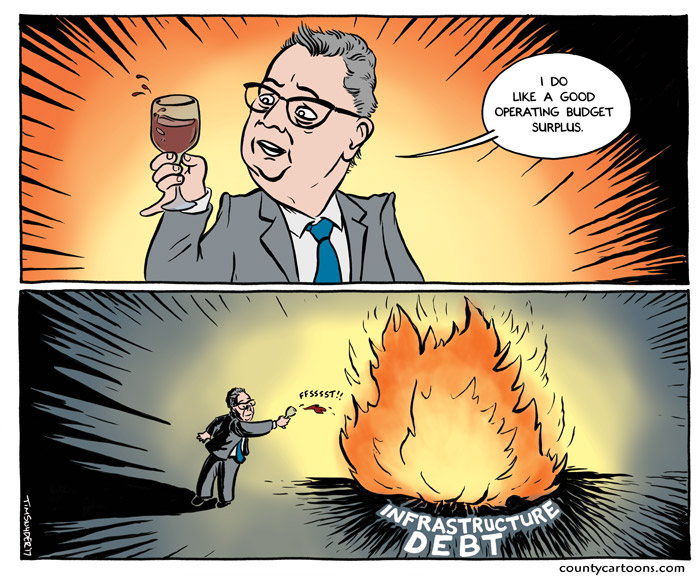
Municipal IT Budget Planning – Part 10: Comprehensive IT Budget for a Municipality
This is the final article in the series – and I am going to try and bring it all home together in one comprehensive Budget. First of all, we need to make some assumptions:
- All equipment will be purchased new by the Municipality.
- Subscriptions will be used for common products: Office 365, Adobe, Anti-Virus, Firewall.
- Full Management of all equipment and services will be outsourced.
- Backups and Disaster Recovery will be hosted Offsite.
- A Cyber Security Assessment and ongoing Countermeasures will be included.
Here is our Budget scenario *:
- New System – or one that’s 5 or MORE years-old and due to be replaced (Little Idea #2 **)
- IT Systems comprised of:
- 1 x Physical HOST server with 4 Virtual (VM) servers
- (Domain Controller, File Server, Exchange Email, & Applications)
- Finance Application uses Microsoft SQL Server database
- 4 Network Devices (Firewall, Switch & 2 x Wi-Fi Access Points)
- 25 Workstations & Laptops
- 1 x Physical HOST server with 4 Virtual (VM) servers
- 35 Users or User Accounts
- 2 Locations (Main Office and Public Works) within 2 KM’s of each other and connected via wireless-bridge.
- Budget Plan: 12 months
Capital Costs:
- New Rack Server Hardware to host 5 VMs (4 x existing + 1 spare): $20,000
- Server Licensing: $21,475
- Firewall, Switch, WiFi Access Points: $4,000
- 15 Workstations: $18,000
- 10 Laptops (with accessories): $26,700
- 50 Monitors: $20,000
- 25 Power Bars: $1,875
- Installation Services (all): $15,250
- Initial Cyber Security Assessment: $5,000
- Sub–total Capital Costs: $132,300
Operating Costs:
- Subscriptions (Office 365, Adobe, Anti-Virus, Firewall): $16,465
- Fixed Cost Management (All Servers, Devices, Cyber Security): $33,800
- Offsite Backup and Disaster Recovery Services: $9,000
- Sub–total Operating Costs: $59,265
Total Budget: $191,565 + 10% Contingency = $210,721 -> $215,000
This combines all of the elements that we had in the previous 9 articles – making allowances for some changes in our assumptions, as we progressed through the series. But let’s take this a step further, and try to predict expenditures for 5 years. We know that the equipment has an estimated life-cycle of 5 years (Little Idea #2**). Thus, to predict budgets for 5 years, simply requires that we extend the operating costs to match. Thus, our 5-year projected budget becomes:
Capital Costs: $132,300
Operating Costs ($59,265 x 5): $296,325
Total Budget: $428,625 + 10% contingency = $471,487 -> $475,000
There are some observations worth noting:
- Moving to Subscription-based software and Support Services makes Budget Planning easy and predictable, as costs remain relatively fixed over the entire period. It also means that Users have the most up-to-date version of the software, even at year-5.
- Having a complete refresh of hardware – while initially expensive – improves User Satisfaction, as all Users are on the same vintage of hardware and performance is uniform.
- The total cost of Ownership over the 5-year period, dwarfs the initial capital outlay. This is hard for many Planners to understand when staring at a large capital expense number; they tend to reduce costs as much as possible on the equipment. That leads to decreased User Satisfaction in years 4 and 5, as equipment specifications cannot provide adequate performance (the BIG Idea**); don’t cheap-out!!
- In the overall context, effective Cyber Security is a bargain ($80,000 over 5 years) (Little Idea #3**.) It’s estimated that the cost of one Cyber Security Attack is north of $150,000.
A final thought: An Industry trend that we’ve been seeing is converting all of the capital and monthly costs itemized above, into a single monthly payment. Some in the Industry call this HAAS or Hardware as a Service. At TRINUS, we use the term Managed Solution Provider – or our version of MSP.
In our scenario, it would amount to a single monthly payment of about $7,900 over 5 years – and takes all of the Planning, Logistics, Deployment, and Support of the entire IT system – and outsources it. We currently have 6 Municipalities on this program, and it is proving very popular and cost-effective.
Please contact me or your Account Manager, if you would like some personalized help with some stress–free Municipal IT Budgeting.
Thanks!
Dave White
TRINUS
stress–free IT
* – Full Disclosure: We’re going to use Services and Prices for TRINUS-supplied Systems and Services. Other Provider costs and equipment may vary.
** – Little Ideas – along with the BIG IDEA – were presented and defined in Part 1 of this series.

















